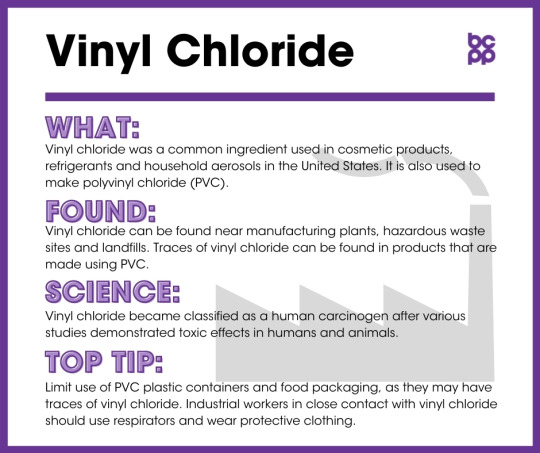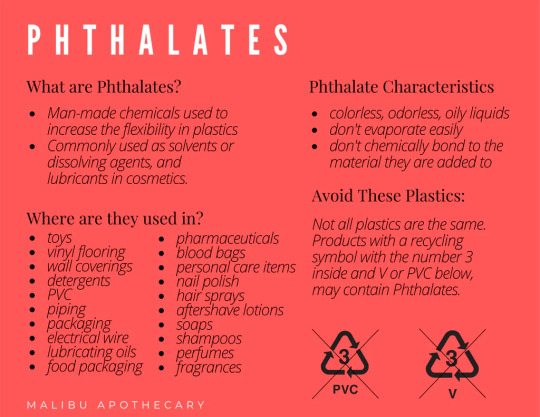Don't wanna be here? Send us removal request.
Text
Chemicals to avoid in consumer products
Endocrine disruptor chemicals are chemicals that manipulate our bodies' natural hormone communication system, known as the endocrine system. These chemicals are often found in consumer products containing plastics and chemical plants.
In this post, I will share several dangerous endocrine disruptor chemicals to try and avoid in your product consumption. Vinyl chloride, BPA, phthalates, and polychlorinated biphenyls are the chemicals I will be reviewing in this blog.
Vinyl chloride is a carcinogenic chemical used to make plastics, it is produced with endocrine disruptor chemicals known as phthalic acid esters (Bi et al., 2021). These phthalic acid esters can potentially cause cancer via confusion and mimicry of the body’s natural endocrine system. Not only can they cause damage to the endocrine system potentially causing cancer, but they can have transgenerational consequences, meaning that the consequences may be felt much later in life, or even by the victim’s offspring (Beatrice & Ruby, 2021). This makes it difficult to hold big chemical companies accountable and pinpoint the exact damage caused. Many of the individuals who get sick due to endocrine disruptors may never know the cause.

(BCPP, 2021)
BPA is another carcinogenic endocrine disruptor used in the production of plastics and resins. BPA stands for bisphenol A (Hafezi & Abdel-Rahman, 2019). Typically, human exposure to BPA comes from exposure to the production and use of plastic consumer products, such as water bottles, food containers, and plastic containers in general (Hafezi & Abdel-Rahman, 2019). As science fights to battle cancer, products containing endocrine disruptors like BPA fight right back (Moss, 2022). BPA performs as a xenoestrogen, meaning that it mimics and manipulates estrogen systems in our endocrine systems. This manipulation can lead to breast, ovarian, colon, and prostate cancers (Hafezi & Abdel-Rahman, 2019). BPA is also damaging to reproduction potential. BPA has alternatives such as BPF or BPS. However, these chemicals can be just as damaging if not worse than BPA regarding human health and chemical exposure (Zhang, 2022).

(Rust & Kissinger, 2008)
Phthalates are endocrine disruptors, which are also found in plastic products. When it comes to the absorption of harmful chemicals, phthalates, BPA, and polychlorinated biphenyls are the greatest concerns (Wang & Qian, 2021). Phthalates can be detrimental to reproduction, development, and neurological health (Wang & Qian, 2021). Phthalates have strong regulations in many countries but are still found in many consumer products.


(Ellis, 2020; Aquino, 2016)
Finally, polychlorinated biphenyls are a carcinogenic endocrine disruptor chemical. Polychlorinated biphenyls are the most studied endocrine disruptors, and they damage neurological functions more than anything (Bell, 2014). Aside from neurological issues, liver disease and cancer are also consequences of the endocrine disruptor known as polychlorinated biphenyls (Bell, 2014). Depression, limbic system damage, reproduction issues, and skin problems are all risks that exposure to polychlorinated biphenyls carries (Bell, 2014).

(What are PCBS? 2016)
While we cannot all create new cancer treatments or stop the production and use of these chemicals, we all can help aid ourselves, our communities, and our loved ones by looking out of these chemicals in our consumer products. The people who produce and push these chemical products should certainly be held accountable. However, we must also hold ourselves accountable if we have a choice in consumption. After all, if we were able to avoid these chemicals entirely, they would become less valuable in theory. On both ends of the issue, accountability, advocacy, and education are the only viable solutions.
References
Aquino, K. (2016, April 20). What are phthalates and should we avoid them? Project Vanity. http://www.projectvanity.com/projectvanity/2016/1/19/what-are-phthalates
Beatrice, A., & Ruby, R. (n.d.). National Center for Biotechnology Information. Endocrine Disruptor Chemicals. https://www.ncbi.nlm.nih.gov/books/NBK569327/
Bell, M. R. (2014, December). Endocrine-disrupting actions of PCBS on brain development and social and reproductive behaviors. Current opinion in pharmacology. https://www.ncbi.nlm.nih.gov/pmc/articles/PMC4298313/
Bi, M., Cui, Z., Liu, W., Liu, M., Li, M., Luan , X., & Liu, W. (2021). Production, use, and fate of phthalic acid esters for polyvinyl chloride products in China. Environmental science & technology. https://pubmed.ncbi.nlm.nih.gov/34617437/
Ellis, C. (2020, November 19). What are phthalates? Malibu Apothecary. https://malibuapothecary.com/blogs/clean-candles/what-are-phthalates
Hafezi, S. A., & Abdel-Rahman, W. M. (2019). The Endocrine Disruptor Bisphenol A (BPA) exerts a wide range of effects in carcinogenesis and response to therapy. Current molecular pharmacology. https://www.ncbi.nlm.nih.gov/pmc/articles/PMC6864600/
Rust, S., & Kissinger, M. (2008). BPA leaches from 'safe' products. Journal Sentinel. https://archive.jsonline.com/watchdog/watchdogreports/34532034.html/
Vinyl chloride. Breast Cancer Prevention Partners (BCPP). (2021, August 18). https://www.bcpp.org/resource/vinyl-chloride/
Wang, Y., & Qian, H. (2021, May 18). Phthalates and their impacts on human health. Healthcare (Basel, Switzerland). https://www.ncbi.nlm.nih.gov/pmc/articles/PMC8157593/
What are PCBS? Spokane Aquifer Joint Board. (2016). https://www.spokaneaquifer.org/what-are-pcbs/
Zhang, H. (2022, February 22). BPA replacement linked to increased cardiovascular disease. EHN. https://www.ehn.org/bpa-replacement-2656483035.html#:~:text=A%20near%2Dubiquitous%20ingredient%20in,be%20as%20harmful%20as%20BPA.
1 note
·
View note